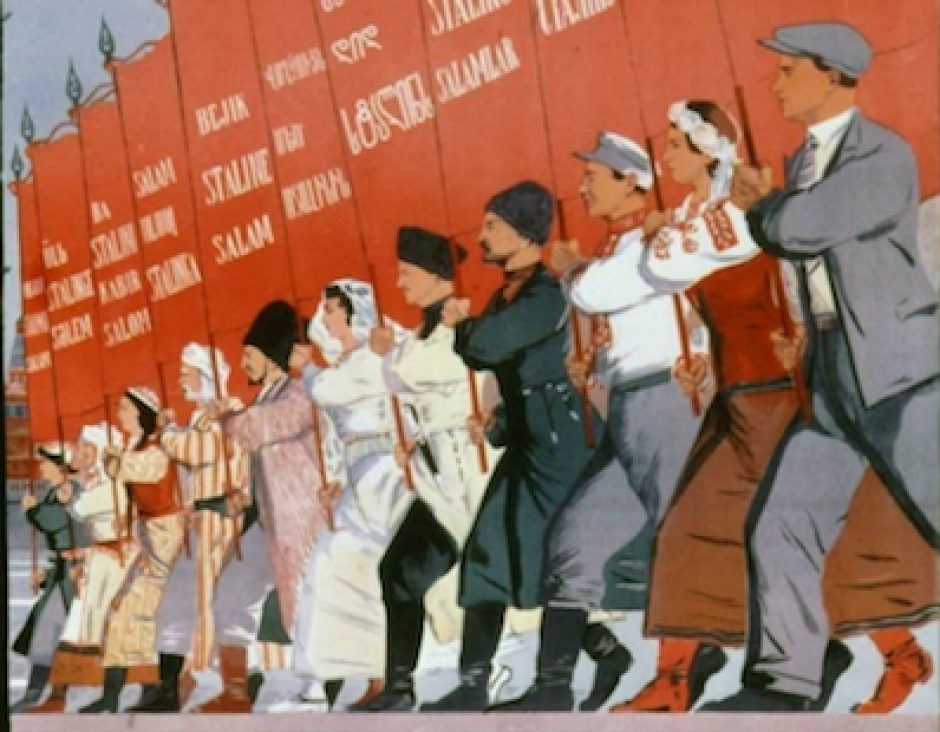Like most places in the world, the nations within the Soviet Union all had rich oral folkloric traditions that helped transmit cultural lessons across generations. However, with the rise of the new regime the role of folk tales grew contentious. During the 1920s, the Formalist school, led by Vladimir Propp, advanced the study of the folkloric tradition, claiming that its oral nature meant they represented the culture of the Soviet working peoples. As the name implies, the Formalist method focused on the structural and formal elements of the composition of folk tales while purposefully disregarding ideological and historical contexts. (Oinas 45) With the advent of the Stalinist era, this analytic method fell out of style. Many believed that the tales promoted a way of life antithetical to the existence of the Soviet Union, often glorifying nobility through magical intervention rather than teaching practical solutions to the problems of the proletariat. This campaign had friends in high places, including Lenin’s widow, who worked to keep the tales out of libraries. (Balina et al. 106) Writers and scholars of literature were therefore expected to put their skills to the advancement of Soviet ideology; simply claiming a vague proletariat tradition was no longer enough to justify the study of the folk tale. Thus, despite once having been heralded as songs of the people, most of the fairy stories passed down through the oral tradition were verboten.

Figure 1. The Ural Mountains. http://www.freeworldmaps.net/russia/map.html.
So: folklorists began to record a new genre of tales “new songs” as opposed to the “old songs.” (Oinas 50) Many took place in a contemporary setting and involved characters interacting with Lenin, Stalin, the Red Army, and so forth. The Malachite Casket represents a departure from this approach because it takes place during a tsarist regime and involves explicit magical intervention. First published in 1939, its author Pavel Bazhov claimed that The Malachite Casket belonged in the genre of the historical, heroic tale rather than the fairy tale. The stories within Bazhov’s collection took place in the Ural Mountains and detailed the lives of the working people. (Balina et al. 114) The following version comes from Politicizing Magic: An Anthology of Russian and Soviet Fairy Tales.

Figure 2. N. Kochergin. In The Malachite Casket by Pavel Bazhov. http://book-graphics.blogspot.com/2013/07/the-malachite-casket.html.
The Malachite Casket is no different. The action begins with Stepan, who has been gifted the titular Malachite Casket from the Mistress of Copper Mountain, presumably for some work he did for her. It’s filled with beautiful jewelry, which his wife Natasya tries to wear but it doesn’t fit her quite right and keeping it on too long hurts her. After he dies, their daughter, who is called Tanyushka, becomes obsessed with the box and the jewelry. Her mother suspects she might be a changeling, and pretty much lets her do her own thing as long as she doesn’t cause trouble.

Figure 3. N. Kochergin. In The Malachite Casket by Pavel Bazhov. http://book-graphics.blogspot.com/2013/07/the-malachite-casket.html.
One day, a beggar woman arrives at the door and Natasya lets her stay, feeds her dinner, is generally a good hostess. This woman gifts Tanyushka a quantity of silk and teaches her how to embroider, thus passing on a profitable trade. Tanyushka also receives a magic button from this mysterious traveller, in which she sees a vision of a beautiful woman in a hall made of the same malachite her father mined from the mountains. Many versions of the tale imply or outright state that the traveller is the Mistress of the Copper Mountain herself, and that she is Tanyushka’s real mother. Although Tanyushka has a new industry, the family is forced to sell the prized casket, which is eventually bought by Turchaninov, the unmarried, reckless master of the village who wants to marry her. She says she won’t consider his suit unless he introduces her to the tsarina, who she believes was the woman in the button, and they decide Turchaninov will get Tanyushka into this castle on Intercession Day.

Figure 4. N. Kochergin. In The Malachite Casket by Pavel Bazhov. http://book-graphics.blogspot.com/2013/07/the-malachite-casket.html.
Upon her arrival in all the finery from the casket, she frantically sprints around this castle trying to figure out what room the woman is in. She finally finds the malachite hall, and meets the tsarina, who belittles her and mocks her. Tanyushka realizes the woman in the button was her own self all along. She tells off Turchaninov, and melts away, leaving behind the gems. The following clip from the 1977 film Stepan’s Remembrance does a great job of demonstrating the anti-tsarist themes of the tale, and depicts Tanyushka arriving at the tsarina’s castle and disappearing.
So the first notable image in that clip is the headless statue, demonstrating how the decadence of the nobility will lead to their downfall during the Revolution. The courtiers laugh at Tanyushka when she arrives, because they think they are superior, but the audience knows their ignorance of her power will cost them. The nobles are flighty and ridiculous, while Tanyushka is serious and committed to her goals. Finally, I think her melting into the wall works on two levels: 1) it aligns the working class of the village with the material used to build this decadence; it rightfully belongs to them and 2) while the nobility may possess the malachite, they can never possess the people’s spirit, which will apparently disapparate just to stick it to them. In conclusion, while The Malachite Casket may be magical tale in form, there is definitely socialist content in its narrative.
Works Cited
Balina, Marina, Helena Goscilo, and M. N. Lipovetsky, eds. Politicizing Magic: An Anthology of Russian and Soviet Fairy Tales. Evanston, Ill: Northwestern University Press, 2005.
Oinas, Felix J. “Folklore and Politics in the Soviet Union.” Slavic Review 32, no. 1 (1973): 45–58. https://doi.org/10.2307/2494072.
